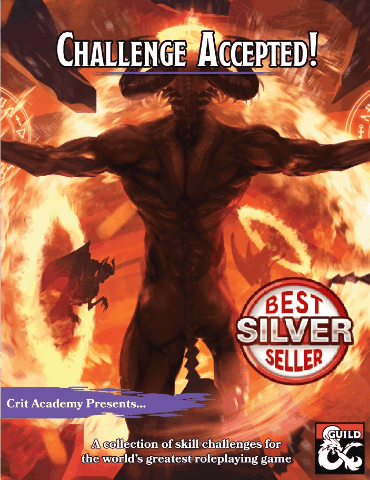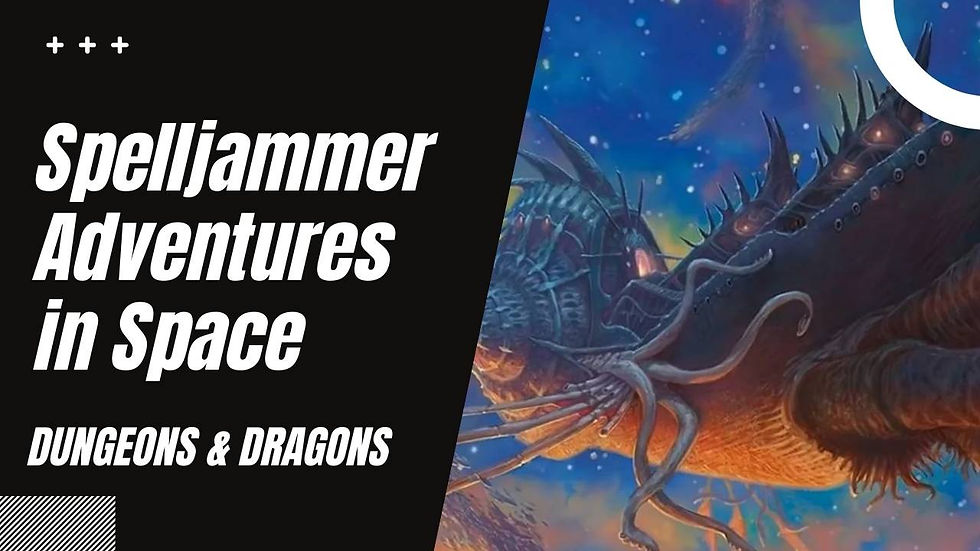Plot Twists in Dungeons and Dragons
- Justin Handlin

- Oct 19, 2020
- 6 min read
Crit Academy covers the awesome Dungeons and Dragons article "Left Hooks: 24 Plot Twists Ideas and Design Patterns" by Jeremy Clarke. We share our thoughts and our own comments on each of his detailed concepts.
Greatest Weakness:
The PCs encounter an enemy of great power. In their current state, and outright engagement would likely be extremely difficult for them. Their investigation has led them to a secret weakness of the enemy. A ritual or item that will allow them to conquer the foe. Unfortunately, they discover that what they thought was a way to weaken the enemy, actually make them an even stronger foe.
Hardened by Fire:
The employer of the PCs or a mentor to them is also the cause of the conflict. The purpose is often to toughen up the PCs or the region in which they are apart of.
Reminds me of the movie Wanted.
A Group of assassins follows a prophecy of the almighty himself. In the hopes of ensuring evil doesn’t rise.
Come to find out, the assassin leader was manipulating the prophecy’s all along. Making him judge, jury, and executioner, not the Almighty.
Ally with an Enemy:
Out of nowhere, a port city is attacked by a fleet of enemy ships.
The port town doesn’t have the resources to fight an effective naval battle. The PC’s must turn to the band of pirates(who they have, up to this point, been tasked with dealing with) for help.
Can the pirates or PCs be trusted? Will both sides stick to their agreement? Or will one side backstab the other?
Rubber Banding:
The longer the PCs take, the more permanent a change starts to become. Creating a sliding scale of success instead of a success or failure condition.
Such a twist creates higher ongoing tension the longer the drama goes on.
For example, a fire elemental takes roost in a nearby volcano. It stokes the fires in an attempt to lead to an eruption. The longer the PCs take, the more violent the volcano becomes. Increasing its frequency as well as how severe it is.
Ash blots out the sun, landslides become more frequent and earthquakes begin to topple buildings.
This is a great example to encourage players to not take long rests, as they work their way to the top.
Did we do that?
The PCs are on the wrong side. The’ve been tricked or forced into supporting the villains goals.
Maybe, the villain is a patron to the group, a mentor or friend.
For example. The PCs have been informed by their patron, that a close personal friend is ill, and that a magic item in the dragon’s lair maybe able to save them. The PCs have been tasked with assaulting a dragon’s lair, or been asked to draw the dragon away. While his subordinate sneaks in to retrieve it.
Unfortunately, the item the patron was after an item to help him take over a city by enslaving a beholder.
Polar Relationship:
An important NPC the PCs are close to work for an opposing cause.
While their goals are the same, the means and reasoning is different, which isn’t discovered until the end. At which point it's too late.
Example:
The PCs are on a mission for a good church. Their goal is to recover a stolen or lost holy relic.
The PCs believe that the return of the relic will return confidence to the church, and hopefully bring in more followers to its “Good and Just” cause.
What they don’t realize, is the church leader is making a power-hungry move. The relic represents a way for them to consolidate power, so they can turn the region into an authoritarian state and make the king/queen a puppet.
Unearthed Tips and Tricks! We bring you new and creative content for you to bring with you on your next D&D adventure.
Character Concept:
Mysterio
This character works as a special effects expert for a circus troupe. He uses chemicals, explosives, and powders to make grand optical illusions, spectacular fireballs. He decided during one show, to use more explosive powder to make the enemy’s attack seem much more fantastic. Unfortunately, the blast was too big. Several actors and a few civilians were killed during the show. He was banned from ever performing. As a result, decided to take to adventuring. Pretending to be a wizard of great power. When in fact, he has no magical talent to speak of.
Monster Variant:
Chained Beast of Nine Hells
This large black dragon appears similar to its kin, with one exception, its wings appear to be missing. In their place, seared to its flesh, black and silver chains appear to be wrapped around its chest. They appear to move on their own as they flail in all directions with an astounding reach. The ends of the chain appear to have small black metal castings forged like dragons heads, with red jewels in their eyes. They stare you down, snapping at the anticipation of devouring your flesh.
Origin: Young Black Dragon
Changes:
Loses Flying
Chains of the Nine hells can be used in place of any of its attacks. If a target is grappled when the attack is made, all damage is bludgeoning.
New Features:
Chains of the Nine Hells: Melee weapon attack: +7 to hit, 20 ft reach., one target. Hit: 11 (2d6+4) piercing damage plus 3(1d6) bludgeoning damage and the target is grappled (escape DC 14). Until this grapple ends, the target is restrained. The dragon has 2 chains, each of which can grapple one target.
Legendary Action: Count: 1
Fling. One Medium or smaller object held or creature grappled by the dragon's chains is thrown up to 40 feet in a direction and knocked prone. If a thrown target strikes a solid surface, the target takes 3(1d6) bludgeoning damage for every 10 feet it was thrown. If the target is thrown at another creature, that creature must succeed on a DC 14 Dexterity saving throw or take the same damage and be knocked prone.
Encounter: Stockholm Syndrome
The heroes are tasked with rescuing a young captured prince from the claws of a succubus. The heroes believe that the prince is being charmed by the succubus and is being forced to be the slave of the creature. During the rescue, the heroes are constantly informed by the prince, that he is is in love with the succubus and doesn’t want to leave. Over the course of his capture, he has truly fallen in love with her. And wishes to remain at her side. It’s up to the PCs to try and confirm the truth. Do they slay the succubus, just to earn the wrath of the prince? Do they confirm the truth and return to their employer with the news? And likely no reward for failing their quest?
Magic Item:
Amulet of Death's Door
This amulet is a set of hinged concentric circles, a smaller ring in front of a larger ring of black iron. In the center of the smaller ring is a plate with a door with a skull etched upon it. It looks very similar to a knocker iron you’ve seen on many chamber doors.
The bearer gains insight and knowledge into medicine. They gain proficiency in the medicine skill.
Once per day. The bearer may spend an action removing all the failed death saving throws from a target within 5 feet of them. The target is not stabilized.
This amulet has no effect on a creature who is dead.
Dungeon Master Tip:
Fatal Flaws:
Combat is a heavy focus of dnd, not surprising considering its wargaming roots and the violence that's apart of many fantasy settings.
We’ve discussed presenting enemies with great power, and that it's ok to throw these at your players.
Sending your players up against insurmountable odds is a great challenge. Especially if they take on the task of discovering how to overcome it. (Outside of just spending lots of time leveling up)
Give your enemy a fatal flaw.
Something, that will bring the powerful villain down to their level.
Make sure to stick clues early on and pepper them throughout their adventures.
This could be a physical object. Think superman's kryptonite.
Or, maybe the villain is extremely vain. Mirror and pictures are everywhere in their keep. Engaging them in a room full of mirrors and use magic illusions or alter their appearance.
Maybe they are extremely cruel. Not just to their foes, but to their allies and comrades. The PCs could maybe convince their subordinates to betray them.
Player Tip: Don’t be a Dick
Never say “My character would never…”
Adhering to personal morals, and codes is an important part of any PC, don’t let I be a stumbling block to furthering the story. Interesting characters rarely deal in absolutes(unless you're sith) and are constantly confronting the consequences of their actions. Especially in situations where there is no “IDEAL” solution. Let your character do something that they will regret later, invite in conflict. It adds depth, I promise.
If you have any feedback, unearthed tips and tricks, or topics you would like us to discuss, please send them to us. You can email them to us at critacademy@gmail.com or find us on Twitter and Facebook @critacademy.
We hope you’ve enjoyed your experience here at Crit Academy. If you did, you can help others find the show by leaving a hopefully 5-star review on iTunes. Or just send us a message telling us how much you enjoy the show.
Also, be sure to give us a like and a share!
Make sure to subscribe to our show at www.critacademy.com, and Youtube so we can help you on your future adventures as well as a chance to win cool prizes each and every week. Make sure to check out our fellowship members as well.















Comments